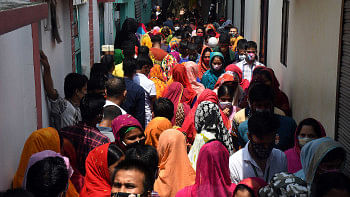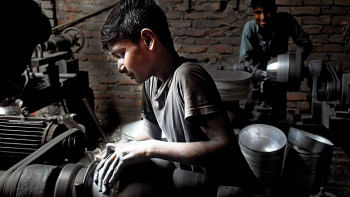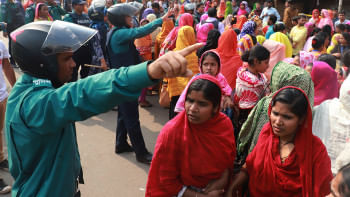Worrying features of our labour market

Bangladesh has been making steady economic progress over the past decades. Since independence, its GDP has increased manifold, from around $6 billion to over $450 billion, while per capita income jumped from around $128 to over $2,700. In 2015, it achieved the status of a lower middle-income country.
To become a middle-income country by 2031 and a developed one by 2041, Bangladesh needs to embrace the Fourth Industrial Revolution, and focus on, among other things, creating a skilled workforce to adequately address several disquieting features of the labour market.
First, although the female labour force participation rate has increased over time, it is about one-half of the male rate. The overall rate, one of the most important indicators of the labour market, increased from around 55 percent in 2000 to 61.2 percent in 2022. The corresponding rates for males and females, respectively, were about 84 and 24 percent in 2000, and 80 and 43 percent in 2022. Women often work at the lowest level of the job hierarchy, with little employment security and low wages.
Second, between 2000 and 2022 (data for 2023 are available for the first and second quarters, and have not been included in the analysis), the labour force increased from 40.7 million to around 72 million, that is by around 1.4 million annually. This is in sharp contrast to the 7th and 8th Five Year Plans' projected annual growth of around two million people.
During the same period, employment increased from 39 million to about 71 million (that is, by around 1.45 million annually). This is in sharp contrast to the 7th plan's estimated additional job creation of around 2.6 million annually. Why was the estimated job creation, let alone "decent jobs," during the 7th plan's implementation not achieved?
Meanwhile, agriculture, forestry and fisheries, the dominant occupational category, declined in relative importance from around one-half in 2000 to about one-third in 2015-16; however, it gained its relative share in 2022, accounting for around 45 percent of the total employed population (largely on account of a sharp increase in female employment in rural areas), followed by services sector (38 percent) and industries (17 percent). Unlike the conventional wisdom that growth in the services sector will follow growth in agriculture and manufacturing, the employment structure in Bangladesh continues to become more service-sector-oriented, predominantly outside of the formal sector.
There is a predominance of informality in the labour market. The increase in employment over time has been largely in the informal sector due to the relatively limited number of jobs created in the formal sector.
The informal sector consists largely of low-productivity, low-wage jobs. The share of this sector increased from 75 percent of total employment in 2000 to around 85 percent in 2022. Such work is considerably more dominant in rural areas, among females, and among the less educated. There are also informal workers (contractual and casual) in the formal sector, who receive lower wages and have no job security. The predominance of informality in the labour market presents a challenge to the creation of an adequate number of "decent jobs." This issue is hindering stable and sustainable development of the economy.
Another indicator of successful absorption of labour is the extent to which the labour force has been moving toward more secure forms of employment. However, the evidence shows that vulnerable forms of employment have remained predominant over the past two decades. There has hardly been any change in the relative shares of the different employment status categories. Self-employed workers remained at around 47 percent, day labourers at around 24 percent, employees 15-17 percent; and unpaid family workers at around 12 percent.
Skill levels of the employed population remain low. Since Bangladesh faces a shortage of the required skilled manpower, industry growth and investments are likely to be severely affected in the future. Also, the relatively low skill level of the workers results in low labour productivity; and it is lower than in several other countries such as Vietnam, India, China, Indonesia, Thailand, and Sri Lanka. The inadequate human capital will be a major limiting factor towards absorption of the projected two million-plus workers annually created during the eighth plan's implementation period.
There is considerable underutilisation of the labour force; and it is higher in rural areas and among females. Furthermore, unemployment increases with education level. The relatively high unemployment among the more educated is due to limited absorptive capacity of the economy to utilise the labour force, with adverse effects on the productive capacity of the economy.
Although the young labour force (15-29 years) increased from 14.5 million (10.4 million males and 4.1 million females) in 2000 to 26.8 million (13.6 million males and 13.2 million females) in 2022, the proportion of employed youth in total employment declined from 88.9 percent (90.5 percent males and 85 percent females) in 2000 to 35 percent (26.7 percent males and 50.3 percent females) in 2022. High unemployment among youth limits, among other things, Bangladesh's ability to reap the benefits of demographic dividend.
Given the need to address the above disquieting features of the labour market, policies should include measures to raise overall productivity of the economy; address bottlenecks to increase investment, especially private investment, by improving the overall investment climate; attach greater focus on high-productivity manufacturing sector, especially export-oriented, and services sectors; make greater investments in human capital to be able to, among other things, reap the benefits of demographic dividend; modernise and further expand the micro, small and medium enterprises; and improve the overall quality of jobs. These measures, if adequately implemented, will have positive effects on the overall employment situation, and thereby, contribute to further growth of the economy.
Barkat-e-Khuda, PhD, is former professor and chairman at the Department of Economics of Dhaka University.
Views expressed in this article are the author's own.
Follow The Daily Star Opinion on Facebook for the latest opinions, commentaries and analyses by experts and professionals. To contribute your article or letter to The Daily Star Opinion, see our guidelines for submission.

 For all latest news, follow The Daily Star's Google News channel.
For all latest news, follow The Daily Star's Google News channel. 











Comments